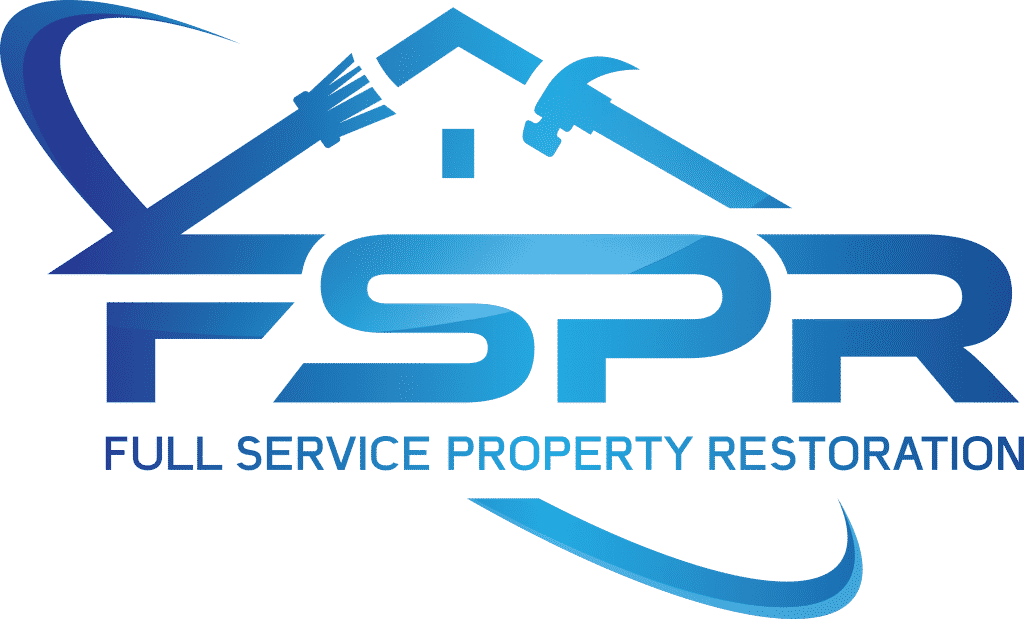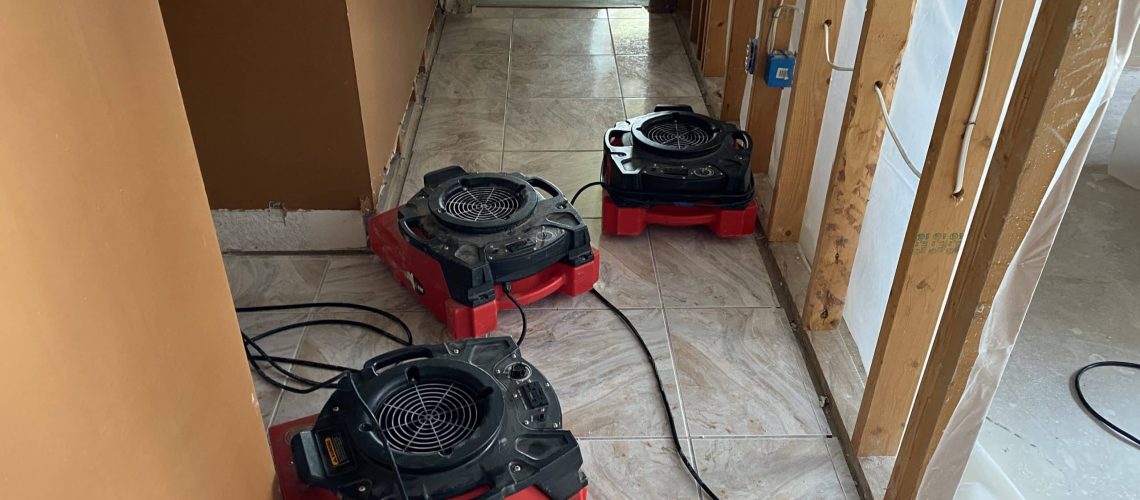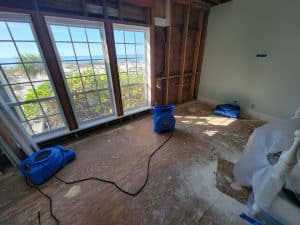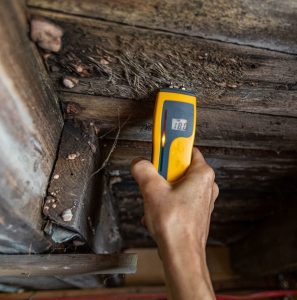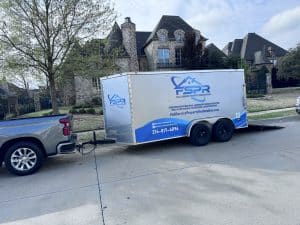When water damage strikes your home or business, it can feel overwhelming. Whether it’s from a burst pipe, a broken appliance, a flood, or a roof leak, the damage can spread quickly, ruining your belongings, weakening structures, and encouraging mold growth as it goes. At Full Service Property Restoration, we’ve seen it all, and we’re here to help guide you through what to do right away.
Taking fast, smart action in the first few hours after water damage can make a big difference in reducing your losses and speeding up the recovery process. Below, we’ve broken down the most important steps you should take right after water damage occurs.
Key Takeaways
- Ensure that the space is safe first before entering any water-damaged areas
- Stop the source of the water immediately
- Document all damage for your insurance claim
- Call a professional water damage restoration company right away
- Begin removing standing water and drying the affected areas (only if it’s safe to do so)
- Protect your belongings by relocating or lifting them off wet surfaces
- Contact your insurance provider and file a claim promptly
- Be aware of hidden damage that may need professional assessment
- Take steps to prevent future water issues with maintenance and detection tools
Step 1: Safety First
Before you even think about cleanup or calling your insurance, make sure it’s safe to enter the area. Water damage can lead to all kinds of safety hazards, including:
- Electrical shock from wet outlets, appliances, or exposed wiring
- Structural damage that might cause ceilings or floors to collapse
- Slip and fall risks on wet flooring
- Contaminated water, especially if the water source is from sewage or flooding
If it’s not safe, stay out and call professionals. Your safety always comes first.
If it is safe to enter:
- Turn off the main power if water is near any electrical outlets or cords
- Wear protective gear like gloves and boots
- Keep children and pets out of the area
Step 2: Stop the Source of the Water
If the water damage is from something internal (like a broken pipe or malfunctioning appliance) your next step is to stop the source of the water.
- Shut off the main water supply if you can’t identify the exact source
- For appliances like washing machines or dishwashers, unplug them and turn off the valve behind the unit
- If it’s a roof leak or window leak, try to contain the area using buckets, tarps, or towels until help arrives
Stopping the source of water is critical to preventing further damage.
Step 3: Document the Damage
Once it’s safe and the water flow has been stopped, start documenting everything for your insurance claim.
- Take clear photos and videos of all of the affected areas
- Include furniture, flooring, walls, baseboards, and personal belongings
- Write down the date and time the damage occurred and any actions you’ve taken so far
This documentation will be essential when filing a claim with your insurance company. The more detail, the better.
Step 4: Call a Water Damage Restoration Company
Don’t wait—get professionals involved right away. At Full Service Property Restoration, we specialize in emergency water damage services and are ready to respond 24/7.
Why call us so quickly?
- We can assess the damage and give you a clear plan of action
- Our team will bring in industrial-grade drying equipment to stop further damage
- We’ll work directly with your insurance provider, helping you navigate the claims process
- Acting fast means you’ll reduce the risk of mold growth, which can begin in as little as 24 hours
Even if the water looks like it’s drying up, there’s usually hidden moisture behind walls, under floors, and in insulation. We know where to look and how to dry it out completely.
Step 5: Remove Excess Water
If you’re waiting for a restoration team and it’s safe to do so, you can start removing standing water:
- Use a wet/dry vacuum for smaller areas
- Use towels or mops to soak up excess water
- Place buckets under leaks to collect dripping water
- Open windows to help with ventilation (only if outdoor conditions allow)
Avoid using regular household vacuums or electrical appliances in wet areas. This is dangerous and can lead to shock or more damage.
Step 6: Protect Your Belongings
Water can destroy furniture, electronics, and sentimental items quickly. Take steps to protect what you can:
- Move furniture and belongings to a dry area if possible
- Place aluminum foil or wood blocks under furniture legs to prevent staining or swelling
- Remove area rugs and hang them to dry
- Take wet items like cushions or books and lay them out in a dry, ventilated space
If certain items are too damaged to save, take photos of them for insurance before discarding, and make sure to discuss with your restoration experts. They may be able to restore the item or give you advice to restore something, even if it seems unsalvageable.
Step 7: Begin Drying the Area
While our team will bring in professional-grade equipment, you can help speed things up by:
- Running fans and dehumidifiers (if the power is safe to use)
- Opening cabinets and drawers to allow airflow
- Lifting carpets or padding if soaked (these usually need professional removal)
- Removing wet baseboards if the water has seeped behind them
The faster you dry things out, the less chance there is for mold and mildew to take hold.
Step 8: Contact Your Insurance Company
Once the immediate crisis is under control and you’ve documented everything, it’s time to reach out to your insurance provider.
- File a claim as soon as possible
- Provide the documentation and photos you gathered
- Ask if they require an adjuster to inspect the damage before cleanup continues
At Full Service Property Restoration, we can work directly with your insurance company and provide them with the moisture readings, estimates, and documentation they need. This saves you a lot of back and forth and speeds up the approval process.
Step 9: Don’t Forget About Hidden Damage
One of the biggest mistakes homeowners make after water damage is assuming everything is fine once the visible water is gone.
Here’s the truth: hidden moisture can cause long-term damage.
- Insulation, drywall, and subfloors can hold moisture for days or weeks
- Mold can start growing within 24-48 hours, even in areas you can’t see
- Weak spots in flooring and walls may not show up until much later
This is why working with a trained restoration team like ours is so important. We use moisture meters and thermal imaging to find and dry out every affected area.
Step 10: Prevent Future Water Damage
Once everything is dried, repaired, and restored, take some time to figure out how to avoid water damage in the future.
- Install water leak detectors in areas with high risk (kitchens, laundry rooms, basements)
- Keep gutters and downspouts clean and well maintained
- Insulate pipes to avoid freezing and bursting in cold weather
- Regularly inspect your roof and windows for signs of wear or leaks
- Know where your main water shutoff valve is, and teach your household members how to use it
A little prevention now can save a lot of heartache later.
Why Choose Full Service Property Restoration?
We know dealing with water damage is stressful, but you don’t have to do it alone. When you call Full Service Property Restoration, you’re getting more than just a cleanup crew. You’re getting a full-service team that treats your home like it’s our own.
We offer:
- 24/7 emergency response
- Certified and experienced technicians
- Industrial-strength drying and dehumidifying equipment
- Direct insurance billing and claim assistance
- Transparent, honest communication every step of the way
From the first phone call to the final walkthrough, our goal is to restore your property and your peace of mind.
If you’ve experienced water damage, don’t wait to act. The sooner you take the right steps and call in the pros, the better your outcome will be. Full Service Property Restoration is here for you every step of the way. Let’s get your property back to normal quickly, safely, and professionally.
Ready to get started? Give us a call now!
